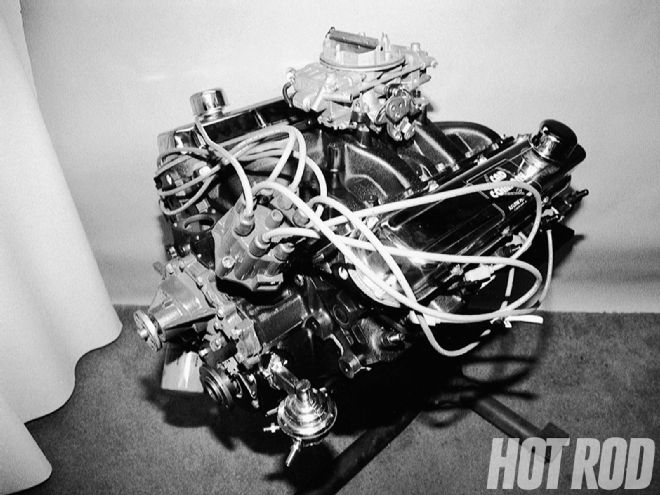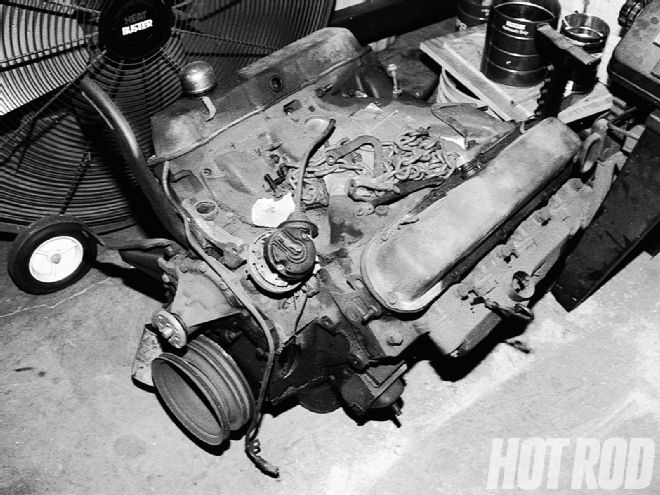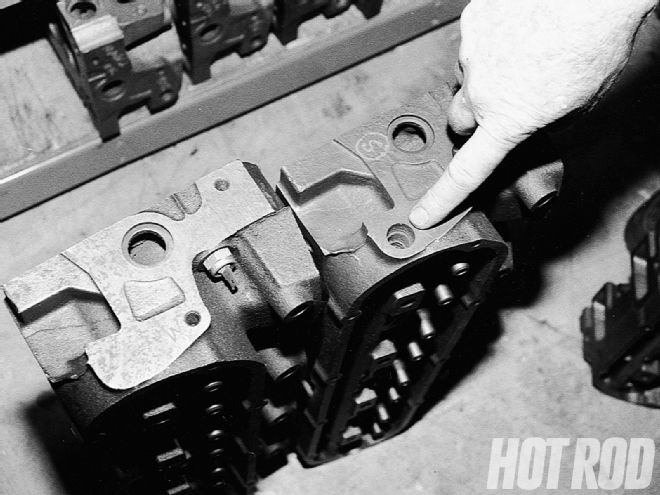
High-Torque Street Engines Producing one horsepower per cubic inch has long been an ideal in the performance world. Remember Chevy crowing about its 283 fuelie motors making a like amount of horsepower in 1957? The more cubes you have, the easier it generally is to make torque and horsepower. So what better way to make power than with one of the biggest production-car engines of the modern era: the 500-inch Cadillac of the '70s.
 Find a 500-cube Caddy engine in the boneyard for about $200. You may even get one for less. It'll look like this, but it's a place to start.
Find a 500-cube Caddy engine in the boneyard for about $200. You may even get one for less. It'll look like this, but it's a place to start.
What better way, indeed. Larry Kruzick of Cadillac Motorsport Development (CMD) in Lakeland, Florida-"the originator of performance Cadillac applications"-posed that same question in the mid-'80s. Since then, Kruzick has become the Lux leader, making possible the swapping of hundreds of big-cube Cadoos into everything from street rods to musclecars to tow vehicles using a conversion kit he developed ("Anchors Away," Aug. '89). If anyone can do 500 torquey, bulletproof, streetable horsepower for a self-imposed limit of four grand, then Kruzick's the man to pull it off with Cadillac style. Even though he's protective of his secrets (don't expect to have a casual conversation about how to build a stroker), he showed us the way to 500 leather-lined horsepower for cheap. Judging by the number of cool Cads that joined us on Power Tour this year, there's plenty of interest among enthusiasts.
The 500-cube motor, also known as the 5200 block (the last four digits in the block's part number), was available in Eldorados from late 1969 all the way through 1976; De Villes got the big 'un in 1975-76. Although a 500 is preferable, the mods we outline here work just as well on a 472.
The part number is cast into the block at the top of the bellhousing flange, adjacent to the oil pressure sending unit. Other, more involved ways to find a 500 include measuring the stroke; at 4.304 inches, it's about 1/4 inch longer than the 472 (4.060 inches). Pull the oil pan and check the crankshaft-500s have a small casting number (a 094 or a 793) between the No. 4 main and the rear rod journal. The 472 casting number is on the edge of the third counterweight.
 The head Kruzick is pointing to is an "emissions" head; an emissions rail helps pump additional air into the head. These are less preferable and tougher to work with than earlier heads (left). Luckily, you can spot them while the engine is still in the car.
The head Kruzick is pointing to is an "emissions" head; an emissions rail helps pump additional air into the head. These are less preferable and tougher to work with than earlier heads (left). Luckily, you can spot them while the engine is still in the car.
You won't be able to tell what year the engine is from the casting numbers on the block. You'll have to yank the valve covers or the heads to see which ones you have. The myriad (and confusing) differences between model years and their respective head casting and piston combos are outlined in the CMD catalog/tech guide, a wise investment for a measly four bucks. For performance applications, 1970-73 250, 902, and 950 casting heads are preferred. Be careful: mix the wrong-year pistons and heads, and you could end up with a compression ratio of 7:1 or 12:1. Kruzick doesn't trust the donor car's VIN as a sign of what's under the hood; he's seen too many incorrect-year engine swaps.
To keep the dollar figures in line, we fudged with a couple of the popular items. The carb and big-block Chevy headers are parts easily available through your local speed shop bulletin board, engine shop, or racetrack newspaper. All other prices in our "Shoppin' List" reflect those in the CMD catalog. Although you may find some non-CMD parts available through other sources for less money, chances are you'll get a better deal overall if you buy the lot as a package from Kruzick.
The Cad 500 was created to be a torque monster. Kruzick knows that the stock valvetrain pieces tend to break at about 5,000 rpm. The rocker arm retaining rail and T-pedestals are vulnerable to valvespring pressure and, without reinforcement, can easily fail at that engine speed. While fixes like forged-steel connecting rods and reinforced rockers are available, and Cads can be coerced to 6,000-plus rpm, the cost of the components was prohibitive for our formula. Kruzick recommends revving a street Cad such as the one we built to no more than 4,800 rpm-well within the peak horsepower and torque bands.
Also, Caddy 500s had a negative-plenum intake manifold; that is, the intake was so low-profile that air had to move up through the runners and into the heads. This restrictive runner design costs power. Kruzick offers the PRO/Cad III intake manifold to take care of that failing. He also reports that, in non-Cadillac-bodied applications employing stock radiators, the engine has been known to overheat. So if you're going to drop your Cadoo into a tight space, like an F-body, try a four-core radiator and a 2-inch spacer block to replace the fan clutch and keep the flow of cool air constant. Beyond that, our formula has a lot of what you'd expect to support more power from any engine: new high-volume fuel pump and oiling system, ignition, and so on.
Our results bear this out. For four grand, our 512-cube Cad pumped out 514 hp at 4,400 rpm on the dyno. Torque? Try a healthy 575 lb-ft at 2,600 rpm on for size, buster. Whether in a De Ville or a Chevelle, that translates to streetable, repeatable low-12/high-11 quarter-mile times. With uncommon class.
Shoppin' List
Block:
'71 Eldorado ("5200" casting), shot-tumbled, magnafluxed,
surfaced, bored 0.040 over (to 4.340)
$440
Pistons:
CMD cast 10:1 pistons with wristpins, Childs &
Albert Dura-Moly rings
$485
Connecting rods:
Stock cast rods, flash-ground, beam-polished,
$69/set bolts
with CMD chrome-moly rod bolts
$96/set rods
Rod bearings:
Michigan/Clevite 77
$50
Heads:
'71 (902 casting), shot-tumbled,
magnafluxed, bronze guide liners, seats recut for Cad Company 2.18/1.86
swirl-polished stainless valves, port-matched and pocket-ported,
surfaced 0.050
inch, 4130 chrome-moly stud kit with nuts and washers
$580
Rockers:
CMD Stage II Shaft Rocker System with special pushrods
$499
Crankshaft:
Stock, polished 0.010/0.010, internally balanced
with stock balancer
$200
Main bearings:
Michigan/Clevite 77 MS970-AL
$80
Camshaft:
CMD PRO/Cad 600H hydraulic (110-degree lobe
separation); includes Super Street lifters, performance
valvesprings, chrome-moly retainers, shims, locks, and seals
$449
Cam bearings:
Durabond
$35
Timing chain:
Cloyes Tru-Roller
$99
Intake:
PRO/Cad III aluminum intake (includes free bolt kit and Cad
Company T-shirt)
$395
Carburetor:
Used Holley 850, PN 0-4781
$140
Ignition:
OEM distributor with new module, reluctor,
adjustable vacuum advance, Mallory cap, rotor, and coil
$105
Oiling system:
Original 6-quart pan and pickup, Cad Company high-volume Gold
pump with Fram PH-25 filter
$129
Fuel:
Cad Company high-performance fuel pump, 65 gph at 81 pounds
of pressure
$119
Exhaust:
Used Hooker #2455 (big-block '70-'72 Chevy Monte Carlo) with
Cad Company header flange kit
$170*
Gaskets:
Fel-Pro, complete
$160
Block hardware package:
Includes brass freeze plugs, pipe plugs, cam plugs and
dowels, and cam galley plug
$20
CMD catalog:
$4
TOTAL:
$4,324
Less 10 percent bulk-purchase discount:
$3,892
* Application refers to a Cadillac body. For
other GM applications, use the appropriate big-block Chevy header for
the chassis in conjunction with the CMD flange kit. CMD offers a
universal adapter kit ($80) to fit Cad 500s in almost any
rear-wheel-drive GM vehicle. (Shipping and assembly costs not included.
Machining prices will vary. Prices correct as of press time.)